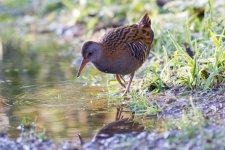Birding on the reserve today
For a cold miserable day, there was a good bit coverage. Those present include Bobby O and Alan H from first light , Bobby P and me later, then Bob W and even the county recorder Steve payne. Later Phil Q and Keith M. The water had risen by at least 3 cm's since Tuesday, due to the outlet pipe being blocked - which I cleared later.
EAST HIDE at MOORS
First thing the lads had 4 buzzards being harassed by a peregrine. Then came the heavy showers and an influx of gulls, but the usual snipe activity during the showers never happened. However a sparrowhawk marauding over the promontory, flushed several out of the thick cover. Only 2 pochard were on site the female flying out soon after it was found, but shoveler had increased slightly. Very little passerine activity away from the feeding station, other than singing cettis warblers.
On to the west side, where 2 water rail fed on the flooded track, with several others calling and showing well in the sluice basin. A little egret dropped into the west hide channel.
Species count MOORS:
GCG 4, little grebe 3, cormorant 21, mute swan 6 (resident pair, ad + 3 juvs) the latter group aggressively chased off site by the alpha male. shoveler 34, teal 55, shelduck pr, pochard 2 (m+f), tufted 20+, coot 220+, water rail c12 min, Little Egret, grey heron, buzzard 4, peregrine, sparrowhawk, snipe 25+, curlew 12 (A38 field), lapwing , BHG 200, LBBG , Herring gull only small numbers, stock dove, jay, kingfisher, green woodp, great sp woodp, cettis w 3, goldfinch 15 east marsh, bullfinch, pied wag 3, reed bunting 6,
SAILING POOL mute swan 4, (ad + 3 juv), GCG 4, tufted pr, cormorant 5, coot 5, water rail hen brook by climbing frames,
FLASHES: The water level had risen by 7cm since Sunday to 0.5. This is the winter level and the sluice is now closed with only 1 slat removed.
The 'meadow' was and well and truly water logged, which in turn attracted the lapwing flock to feed there. Several snipe slept on the southern shore and others were flushed by the grazing cattle. Good numbers of thrushes fed in the east fields and a small flock of linnet landed in front of the hide.
Species count FLASHES:
Greylag 30, teal 32, coot 5, mute swan 4(ad +3 juv overhead), moorhen 25, snipe 20+, lapwing 273, BHG 25, buzzard, sparrowhawk, stock dove 2, Raven 2, green woodp, fieldfare 120, redwing 30, song thrush 2, linnet 12, grey wag, chiffchaff







